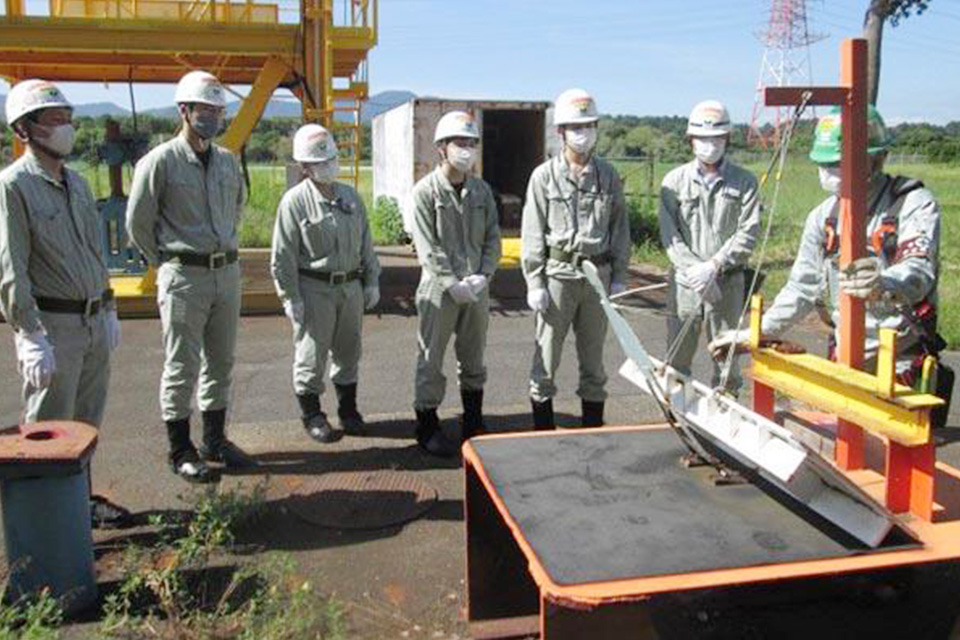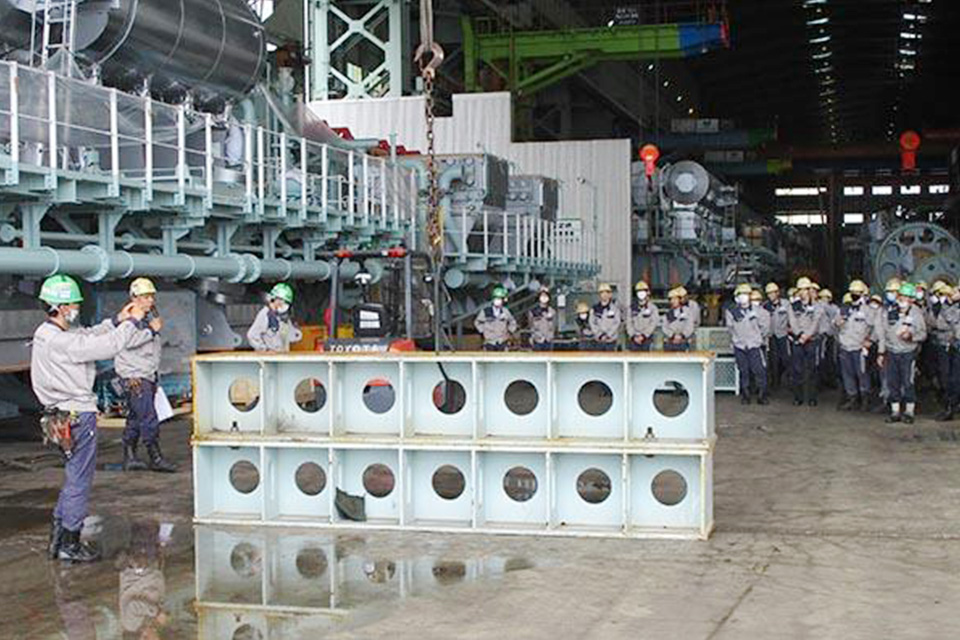Health and Safety Management
Basic Policy
We will achieve the followings by instilling a safety culture in each workplace and fostering human assets:
- Safety first principle, for manufacturing and engineering practices as top priority to safety
- Creating a comfortable workplace by proactively working on physical and mental health management
Targets
| Deaths, serious injuries, or lost-worktime accidents: | 0 |
|---|---|
| Accident frequency rate: | 0.6 or less (Goal: 5 or less accidents without lost-worktime) |
| Work-related illnesses: | 0 |
|---|---|
| Non work-related injuries and illnesses: | Days off work frequency rate of 0.38% or less (Of which, mental health disorders are 0.11% or less) |
High-priority issues
(1) Safety
- Prevention of severe occupational accidents
Based on lessons learned from past cases of severe occupational accidents (especially at our own workplaces), it is the responsibility of managers to implement and disseminate risk assessment (RA) to ensure that serious accidents do not happen again. - Thoroughly implement facility maintenance and upkeep management
Ensure that periodic inspections are performed and that "preventive maintenance" to repair or replace equipment is thoroughly carried out. Maintain the surrounding facilities, equipment, and environment to ensure safe facility operation. - Creating a Safe Working Environment
The health and safety manager is responsible for the workplace environment and for guiding safe work. Everyone in the workplace builds trust through good communication. Establish a safe working environment for both parties. - Elimination of Pinching and Entanglement Accidents
For equipment and tools that pose a risk of pinching or entanglement, we will thoroughly explain their structure and implement engineering measures. We will also develop and educate on work standards that cover safety matters comprehensively, making them easy to understand even for inexperienced workers.
(2) Health
- Promote health management
Think about health from a management perspective and under- stand health issues, strategically putting health management into practice. - Promote mental health care
Create a good place to work by promoting these 4 types of care: 1. Self-care, 2. Line-care, 3. Care from occupational health staff, and 4. Care from resources outside of the workplace. - Promotion of "work-life balance" and measures to prevent overwork
Ensure the implementation of systems and measures to optimize working hours, and achieve a work-life balance by reducing mental and physical fatigue.
Events
To promote and thoroughly implement key initiatives and various safety and health activities, the following events will be held:
(1) Safety and Health Inspections
- Central Labor-Management Joint Safety and Health Inspection (twice a year): Inspect the status of safety and health management.
(2) Company Events
- Workplace Safety Awards: Award workplaces with good safety performance from the previous year
- Team Safety II (TS II) Movement Awards
(3) Cooperation with Labor Union and Government Events
- MITSUI E&S Labor Union Federation Safety and Health Awareness Month" (February)
- National Year-End and New Year Accident-Free Campaign and Year-End and New Year
Traffic Safety Campaign (from December to January)
(4) Monthly Events
- National Safety Week and "Safety and Health Emphasis Month" (from July to August)
- National Industrial Health Week and "Industrial Health Month" (October)
(5) Others
- Safety and Health Mottos
- Safety and Health Slogans
Efforts to Prevent Labor Accidents
Reducing Labor Accident Risks through Risk Assessment
Based on our Work Safety and Health Management System, we examine potential accident risks that may be hidden in workplace. Moreover, we estimate and evaluate the degree and frequency of labor accidents through risk assessment. This allows us to take action in relation to issues that present a greater risk. By continuously taking part in such risk reduction activities, we strive to prevent labor accidents and reach a stage where safety is an intrinsic part of our organization.
| FY2018 | FY2019 | FY2020 | FY2021 | FY2022 | |
|---|---|---|---|---|---|
| MITSUI E&S Group | 0.22% | 0.24% | 0.3% | 0.15% | 0.28% |
| Manufacturers *1 | 1.20% | 1.20% | 1.21% | 1.31% | 1.25% |
| The Shipbuilders’ Association of Japan *2 | 0.86% | 1.00% | 1.13% | 0.80% | 0.75% |
*1 Occupational accident statistics of Japan Advanced Information Center of Safety and Health
*2 Statistic data from The Shipbuilders’ Association of Japan
Implementation of Danger Sensibility Improvement Training
Danger experience training
As part of its efforts to enhance safety education, the MITSUI E&S Group provides training programs run by the Safety Group at each business location that enable employees to experience dangers for themselves. By establishing a safety training center at each business site, employees will be made aware of the dangers of their daily work sites through scenarios based on actual accident / disaster cases. This training is conducted not only for employees working at the work sites themselves, but also for employees working in the office. In this way, the entire Group is working to raise safety awareness and achieve a zero incident rate for accidents and disasters.
Conducting near-miss demonstration training to improve sensitivity to danger
The MITSUI E&S Group conducts regular near-miss demonstrations aimed mainly at young employees and workers with few years of experience.
We seek to improve sensitivity to risks by conducting reconstruction tests and having employees take part in hands-on training based on near-miss cases that actually occurred both inside and outside the company (cutting of sling wire ropes, falling heavy objects, etc.)
Danger experience training


